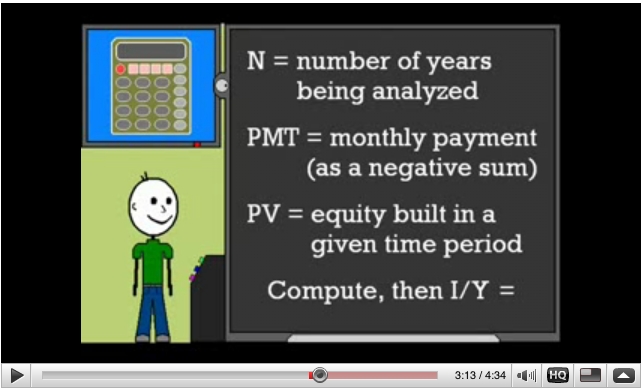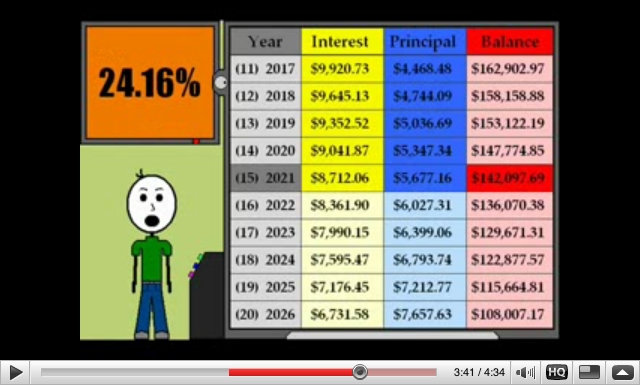I’ve used the term Innumeracy here to describe the equivalent to numbers what illiteracy is to reading. However, I now seek a stronger word or phrase to describe the egregious claims I’ve run across. I’m leaning toward “numerical blasphemy,” but am open to suggestions.
A Money Merge Account agent sent me a link to a You Tube video titled Truth in Lending. The author wanted to illustrate the concept of “front-loaded” interest on a 30 year mortgage. I’ve never seen a post that started with that idea end in anything that made sense, this video was no different. The video itself was well done, nice animation and voice over, but the numbers soon fall apart. I’ll offer two screen shots that show this.
As this slide came up, it seemed innocent enough,unfortunately it ends incorrectly. When working with a financial calculator you need to be very specific. N is not the number of years but number of payments, in the video’s example, 360. PMT, the payment, can be positive or negative depending on the calculator. Excel looks for it to be negative, a classic TI BA-35 calculator, positive. PV is not the equity built, but the present value of the mortgage, starting at the borrowed amount, and of course, ending with a FV (future value) of zero. He then says Compute, but there are two variable missing, %i (the interest rate) as well as FV. So, while I have no idea what his intention was, he now suggest taking I (the interest rate, I suppose) and dividing by Y (years, but why?) to produce a number which is admittedly large but meaningless.
Here, you can see that he author suggests that somehow the interest rate over 15 years is over 24%. But, back to a calculator or spreadsheet, we can see that PV = $200K (original loan) i = .5% (monthly rate or 6%/12) N=360 months (30 years) FV = 0 (after 30 years it’s paid to zero. If we enter these numbers we can comput the missing variable, the payment, which is $1199.10. Then it’s simple to set N to 180 (year 15) and compute the new future value, $142,097.69, as he shows above. On the other hand, we can enter PV =$200K, i = .5%, PMT = $1199.10, N=180 and FV = $142,097.69, and ask to calculate the rate, which of course comes back as .005 or 6% per year. By the way, it’s easy to look at the interest column above and divide say, the 2021 interest into the prior year ending balance and see you get under 6%. A couple hundred video views and no one saw how silly this all was?
As far as front loading is concerned, there’s nothing diabolical in how mortgages are calculated, you owe interest on the principal outstanding at any given time. Since you owe far more in the early years, more of your payment is interest. On this example $200K mortgage, in the first month the interest is $1000, but the principal paid is only $199.10. Pay more if you wish, that’s your decision. But don’t fall for an abomination of bad math. What does this have to do with the Money Merge Account? Only that every time I see numbers abused this badly I’m reminded of my friends at UFirst and the MMA.
Joe



I am amazed at your patience and perseverance in your blog dealing with those afflicted with numericosis (a widely spread cognative condition whereby math skills regress to pre-school level — my definition).
I also admire your ability to methodically prove the impossibility of the many absurd Merge Account claims of its pitchmen. I came to the same conclusions, but I simply relied on instinct honed by years of practicing math since graduating fourth grade. However, a Hungarian proverb may say it best: “One can not paint Easter eggs with fart”; i.e. something of value can not be created from nothing, especially if it stinks to start with…
Unless funded by the Toothfairy, any significant principal reduction could ONLY come from the Merge Account scam victim, enabled by his necessarily altered budgeting (lifestyle).
Not surprisingly, numericosis makes rational thinking impossible for those afflicted, rendering them incapable of making sound judgments whenever math, let alone the time value of money is involved. As a result, selling agents adopt the faith based hyperbole spewed by the companies behind the Merge Account scams.
Conspicuously immune are those who embrace basic math and logic as the best known arbiters of reality.
In my judgment, it is only a matter of time before before the largest of the Merged Account companies is criminally prosecuted.
Best regards,
Peter
Hi Joe,
I wanted to thank you for committedly blogging about this. It’s a fresh read from the nasty comments people leave on public forums, hiding behind their anonymity. At least here we can get consistent real math examples.
I’d love a copy of the spreadsheet I can use and the full PDF version of your blog. Unfortunately at the end of each blog entry you can’t click a link to the follow up, only to previous entries and related ones.
Keep up the good work.
Shifty
Joe,
I’ve begun marketing a great new health drink… Just kidding. I have a question for you, probably answered somewhere in the anti-MMA posts with which I was pummeled last summer but whose answer I seem to have forgotten.
Is the “HELOC Shuffle” concept itself flawed or is the objection to MMA strictly because (a) it is insanely overpriced and (b) there’s a software glitch that changes expenses depending on pay frequency? In other words, if MMA were free and expenses were fixed, would shuffling money through a Heloc actually work better than adding the same amount to principal each month (using your spreadsheet, for example)?
Thanks for any additional help you care to provide to cure my innumeracy. Hope all is well,
NJB
Good to hear from you!
My best HELOC Shuffle explanation is The UFF Money Merge Account money shuffle explained.
I’ll run through my thoughts here. There are really three factors, dials to turn numbers or time up/down. First is the rate of the HELOC vs the mortgage. If the HELOC is below the mortgage any decision must be the client deciding how long that will last. The risk is that rates will rise back up. Side note – I have this issue myself. My mortgage is 4.99%. HELOC 2.5% and it’s bottomed, the prime can go up .5% and HELOC is still the 2.5% rate. $50K on the HELOC would save me $1250/yr at the outset. At the HELOC goes above the mortgage rate, the other two factors come into play.
First, using the UFirst classic example of $5K income/$4K expenses, we can see that the earlier the income is earned, the higher your average daily balance. The same effect for when bills are due. So in the extreme example I use to prove a point, If you earn the $5K on Day one, but all bills are due on the 30th, by borrowing $5K on the 30th and paying it back on the 1st, you now filled the gap, ad have $5K to send to the mortgage up front, and only borrowing this amount 12 days over the year.
But – most people are paid over the month, and it averages mid month by definition, so even with late bills, this savings quickly dwindles. The potential savings comes from “filling gap” between the average daily balance and the total monthly income. Borrowing $2K at 6% to let you sent $5K to a 5% mortgage for example will cost you $120 to save you $250, a net $130/yr savings. A lot of shuffle for little savings, all in all.
Make sense?
Joe,
Thank you for the detailed reply and sorry that I may have wasted your time. I forgot that as a (reformed, no longer practicing!) MMA agent, I still have analysis software and as such, could have – as I just did – input the parameters and run an MMA analysis against your spreadsheet.
I used the $200k fixed-30 @ 6% standard, with an extra $500 of “discretionary income” and pay-period of semi-monthly. To remove UFF’s fee from the picture, I had it taken from Savings which I listed as a total of $3,750 so it would leave the savings account open with $250 in it (used $250 for checking also). Results:
MMA Payoff – 176 months; total loan cost $301,804
JoeTaxpayer – 178 months; total loan cost $302,534
The “Heloc Shuffle” has a marginal utility of almost zero and given that there are identified glitches in the MMA software, I would not even rely on its output that shows it to beat a simple Excel spreadsheet (in this case) by $730.
Off to dream about factorial math! Thanks again.
NJB
NJBlue- never a waste for me, the more I explain the system, the better off people are who read this, they can see how MMA is mostly smoke and mirrors. A $730 advantage for a $3500 cost? Where’s all the savings? They want to take credit for tens if not hundreds of thousands in savings.
Thanks again for the visit.
Hi Joe,
We recently received a UF brochure for a MMA (no real detail in the brochure) so I did a Google search to get information/public comments, receiving their link plus yours (in the top 10). I have to agree with Peter’s above August 10, 2009 comment on “your patience and perseverance” in trying to clarify the utility (or lack thereof) on these programs.
Thank you for clearly outlining the issue/problem with these MMA “solutions”. On our mortgage, we have simply always done your main recommendation, put significant additional amount on our monthly payment.
I would like to receive the MMA_Sheet Excel spreadsheet you freely distribute.
Again thank your for all the detailed reviews and explanations.
Best regards,
Ron
It’s the first link on the page http://www.joetaxpayer.com/money-merge-account-links/
Much thanks for your kind words!
I have downloaded it. Thank you for the quick reply and the link.
From your home page, hoe do you find the above link?
Ron
? Now that you mention it, I don’t know. I should have it linked from each MMA article.